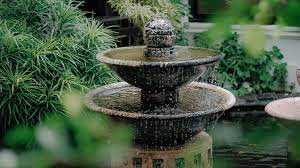Introduction to Water Features
Water features such as fountains and ponds have long been prized for their ability to enhance outdoor spaces, adding beauty, tranquility, and a sense of serenity to gardens of all sizes. Whether you have a sprawling backyard or a cozy urban garden, incorporating water features can transform your outdoor space into a peaceful oasis that delights the senses and nourishes the soul.
Benefits of Water Features
The benefits of water features extend beyond mere aesthetics. They provide a multitude of advantages for both you and your garden ecosystem. Firstly, water features add visual appeal, creating focal points that draw the eye and create a sense of harmony within the landscape. Additionally, the sound of flowing water can promote relaxation, reduce stress, and mask unwanted noise from nearby streets or neighbors. Moreover, water features attract a variety of wildlife, including birds, butterflies, and amphibians, contributing to the biodiversity of your garden. From an environmental perspective, water features help maintain humidity levels, cool the surrounding area, and provide habitat for beneficial insects and microorganisms.
Types of Water Features
There are various types of water features to choose from, each offering its own unique charm and benefits. Fountains come in a range of styles, from classical to contemporary, and can be freestanding or integrated into existing structures. Ponds provide a more naturalistic look and offer opportunities for aquatic gardening and fishkeeping. Waterfalls add drama and movement to the landscape, while streams and creeks create dynamic pathways that meander through the garden.
Design Considerations
When planning a water feature for your garden, several factors should be taken into account to ensure its success. Consider the size and scale of your outdoor space, as well as its existing layout and features. Think about the location of your water feature in relation to sunlight, shade, and existing vegetation. Choose materials that complement your garden’s aesthetic and are durable enough to withstand exposure to water and weather. Finally, factor in maintenance requirements and budget considerations when selecting the type and design of your water feature.
Installing a Fountain
Fountains are a popular choice for adding elegance and movement to garden spaces. When installing a fountain, it’s essential to choose the right size and style to suit your garden’s scale and design aesthetic. Consider the placement of the fountain to maximize visual impact and ensure proper water circulation. Invest in a quality pump and filtration system to keep the water clean and free of debris, and follow manufacturer recommendations for maintenance and care.
Creating a Pond
Ponds are another fantastic option for introducing water into your garden. Before building a pond, carefully plan its location, size, and shape to ensure it integrates seamlessly with the surrounding landscape. Excavate the area and install a flexible liner or preformed shell to contain the water. Add edging materials such as rocks or bricks to create a naturalistic border, and consider incorporating features like waterfalls or streams for added interest. Install a filtration and aeration system to maintain water quality and support aquatic life.
Landscaping Around Water Features
Once your water feature is in place, it’s essential to landscape around it to enhance its beauty and ensure its longevity. Choose plants that thrive in moist conditions, such as water lilies, irises, and cattails, to soften the edges of ponds and fountains. Incorporate hardscaping elements like stepping stones, bridges, and seating areas to provide access and create focal points within the garden. Install lighting fixtures to highlight the water feature and extend its enjoyment into the evening hours, and consider safety measures such as fences or barriers to protect children and pets.
Maintenance and Care
Regular maintenance is key to keeping your water feature looking its best and functioning correctly. Clean debris such as leaves, twigs, and algae from the water surface and surrounding area to prevent clogging and maintain water quality. Monitor water levels and refill as needed to compensate for evaporation and splashing. In colder climates, winterize your water feature by draining pumps and storing sensitive plants indoors to protect them from freezing temperatures. Be proactive in addressing any issues that arise, such as leaks, pump failures, or algae blooms, to prevent them from escalating into larger problems.
Enhancing Your Garden
In addition to their practical benefits, water features can add a touch of magic and wonder to your garden, turning an ordinary space into an extraordinary one. Consider adding aquatic plants like water lilies, lotus, and water hyacinth to your pond to create a vibrant and biodiverse ecosystem. Introduce fish and wildlife such as koi, goldfish, and frogs to bring your water feature to life and promote ecological balance. Blend your water feature seamlessly with other garden elements such as pathways, seating areas, and planting beds to create a cohesive and inviting outdoor environment. Above all, let your creativity and imagination guide you as you personalize your garden and make it a reflection of your unique style and personality.
Conclusion
Water features offer a multitude of benefits for both gardeners and garden ecosystems alike. From enhancing visual appeal and promoting relaxation to attracting wildlife and supporting biodiversity, fountains and ponds have the power to transform outdoor spaces into havens of beauty and tranquility. By carefully planning and designing your water feature, selecting the right materials and plants, and implementing proper maintenance and care practices, you can create a stunning and sustainable garden oasis that brings joy and inspiration to your life for years to come.

